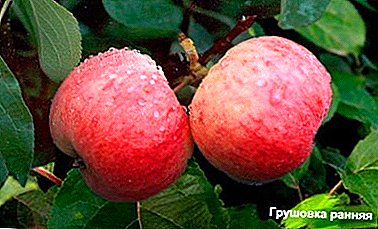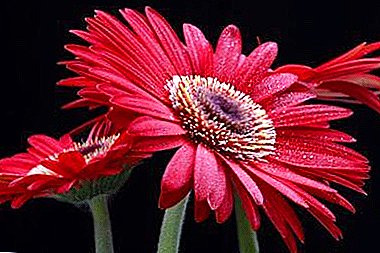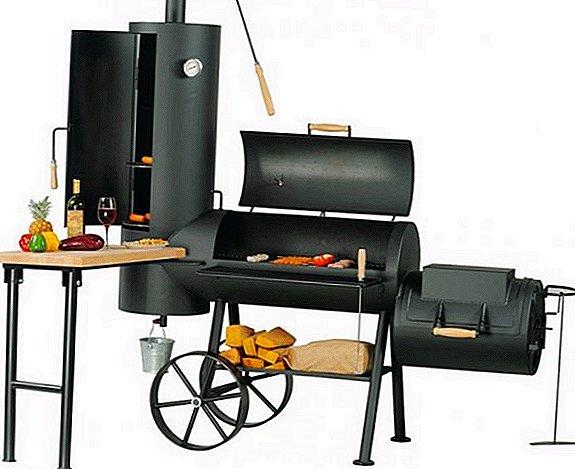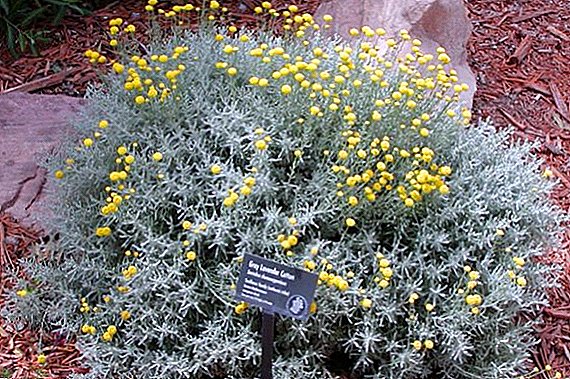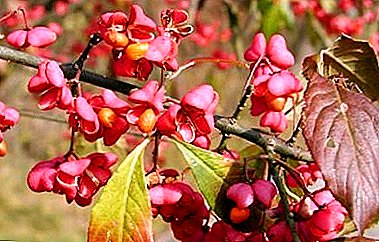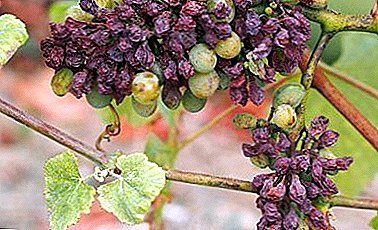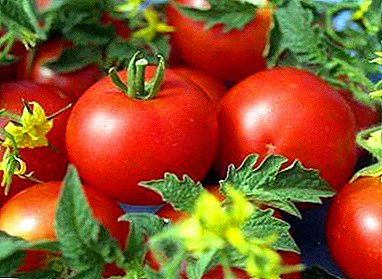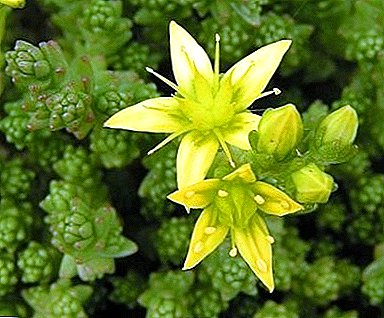 It is beneficial to breed geese because of their excellent fattening qualities, good livestock safety and egg production. Under favorable conditions, a 4-pound bird with nutritious meat, high-quality down and feather grows out of a small chick after 2 months. Learn the secrets of growing goslings at home.
It is beneficial to breed geese because of their excellent fattening qualities, good livestock safety and egg production. Under favorable conditions, a 4-pound bird with nutritious meat, high-quality down and feather grows out of a small chick after 2 months. Learn the secrets of growing goslings at home.
Self-breeding goslings at home
Geese are distinguished not only by their productivity, but also by their rapid adaptation to the environment of their content. At home, these unpretentious wards can grow with a hen or in an incubator. Consider both options.
Important! Eggs with two yolks, irregular shape, flaws or cracks in the shell, blood clots in the gaps, improperly located or excessively large air chamber are not suitable for incubation.
Incubator
It is much easier to breed young offspring with the help of a goose-hen. But if there is no such possibility, an artificial apparatus will help out. Breeders should be prepared for the expected problems, because the eggs of this bird are large in size and contain many useful substances. Together, these factors affect the ratio of hatched chicks and the number of egg-laying. Normally, the figure is 70 percent. You can increase it, knowing how to lay eggs in the trays of the device, and how to take care of them in the future.  Novice poultry farmers should take into account the peculiarities of the incubator breeding of goslings:
Novice poultry farmers should take into account the peculiarities of the incubator breeding of goslings:
- For these purposes, for only 10 days, only fresh eggs with the correct oblong-oval shape are selected. They should never be washed, but disinfection with a weak solution of potassium permanganate is allowed.
- 3-4 hours before laying the incubator is heated to a temperature of +39 ° C.
- During the laying of eggs, it is important to ensure that the lid of the apparatus does not damage the shell, which often happens because of their large size.
- After all the selected specimens are placed in egg trays, the device should be in the temperature regime of + 38 ° C for 4-5 hours. Then, in order to avoid overheating, this figure is first reduced to +37.2 ° С, and after 1-2 hours to +37.5 ° С.
- It is important that each egg warms evenly. This problem is solved by itself in automatic incubators, and in semi-automatic and primitive simple models, the owner must carry out the process of turning the eggs at least 6-8 times during the day. Otherwise, the favorable environment for the correct development of the embryo will be disturbed, and the overheated shells will adhere to the adjacent parts of the incubator.
- After a 15-day period, incubators of any brand and design must be aired.
Find out how much and how the goose eggs are stored for the incubator, as well as when the geese start to be born.
Hen goose
This method of breeding domestic geese in the poultry industry is considered very easy and does not require additional intervention in natural processes. But sometimes it happens that the goose has poorly developed maternal instincts. Then it is better to use an incubator.  If this problem has not touched you, you should take care of comfortable conditions in the house. It is important that the room is always dry and clean, and thermometer mark never fell below 14-15 ° C heat. Ventilate it periodically and do not overload the hen's nest with eggs. One individual can sit a maximum of 14 chicks.
If this problem has not touched you, you should take care of comfortable conditions in the house. It is important that the room is always dry and clean, and thermometer mark never fell below 14-15 ° C heat. Ventilate it periodically and do not overload the hen's nest with eggs. One individual can sit a maximum of 14 chicks.
It is better to isolate it from other feathered brethren so that the birds will have access to water and food. Ensure that there is fresh water in the drinker every day.
The brood will be born only after 28 days, so do not leave the goose for a long time without food. If necessary, she should go for a walk and this should not be hindered. But after 10-15 minutes, the hen must return to its place.
Prefer for chicks Toulouse, Kholmogory and Linda geese breeds. They independently roll eggs to heat them evenly and faithfully fulfill their mission.
Important! During the incubation period, it is necessary to inspect the condition of the masonry twice: on the 11th day and on the 27th day. Select unfertilized eggs, they are bright on the lumen, without a dark spot of the embryo. Eggs with a dead embryo are also removed from the nest, in which dark rings are viewed along the vertical or horizontal axes. On the second inspection, the dead embryos are viewed as a solid dark mass.
How to care for goslings from the first days
From the first days the hatched chicks require additional care. Otherwise, the brood may die. How to prevent mortality, and what should the poultry farmer do at this stage? 
Corral
Even with a synchronous magnifying glass, you should not leave the goslings in the nest in the nest. They are immediately taken to separate box and heat tube way. They will return to the hen when the last goose from the clutch appears. Experienced gusevody advised to return mother brood in the evening.
In the future, the maintenance of the new family should be carried out in a separate pen. For this, a small shed will fit, in which you first need to disinfect the walls with lime. This bird has a roof over its head and a clean, dry corner.
Familiarize yourself with the breeds of domestic geese and the basics of their breeding: Arzamas, Hungarian white, Rhenish, Danish legart, Tula, Chinese, large gray, as well as the largest and white geese.
Keep in mind that too cramped conditions are the most common cause of death of young animals, so immediately distribute the area correctly.
Experts recommend placing birds per square meter:
- 10 goslings from 1 to 30 days old;
- 4 geese aged 1 to 2 months;
- 2 geese older than 60 days.
 Strictly unacceptable in the goose-down draft and cold. Choose rooms with a warm floor, the materials of which do not accumulate moisture. Also, without fail, provide ventilation hatches.
Strictly unacceptable in the goose-down draft and cold. Choose rooms with a warm floor, the materials of which do not accumulate moisture. Also, without fail, provide ventilation hatches.
Did you know? In the United States of America, geese are also used for weeding beds on plantations. The fact is that they do not eat cotton, and weeds are destroyed very effectively.
Litter
It is advisable to lay the floor in the pen with a layer of straw, 10-15 centimeters thick. If the street has not yet established consistently warm weather, it will not be out of place to have a heating pad. Indoors cleanliness is important, so clean the dirty litter in a timely manner and monitor the air temperature.
It is categorically not suitable for gooseberry barley straw and other long-grain grains. Also avoid wet and stale material with mold elements. 
Temperature
From the first days of life for goslings temperature is important. In the cold, they will lump together and crush each other, and in excessive heat they may die. Besides, temperature parameters must match the age category of chicks:
- conditions are recommended for individuals of the first week of life at +27 - +28 ° С;
- Goslings from 15 days of age show a temperature in the range of +24 - +26 ° С;
- the brood, which lived to 20 days after hatching, may be in conditions of +18 - +23 ° С.
Did you know? Geese are long-lived and can live more than a quarter of a century.
Lighting
For the young, daylight hours should last not less than 14 hours. But if you install lamps for heating, which will continuously work throughout the day, the young will not suffer. On the contrary, in the first 7 days of life, goslings need the support of the temperature regime, and such care will be just the way for them. Long-term coverage will help to improve the metabolic processes, which in turn will lead to a good appetite for the wards, as well as their growth.
Video: goose brooder
During the day, in clear, warm weather, the young with their mother from the first days of life can be let out on the street for walking. Better for that equip a small aviarywhere birds will be protected from predators and other hazards. In this way, you gradually accustom your birds to pasture. 
Humidity
In conditions of poor ventilation, dampness is observed in the goose-bob, which ultimately leads to a massive loss of livestock. Therefore, experts advise to periodically ventilate the room and prevent air from stagnating in it. Optimum humidity should not exceed 65 percent. In warm weather, ventilation hatches can be left open even at night. Also keep an eye on the cleanliness of the litter, because this is one of the main factors that influence the humidity of the atmosphere in the house. Ideally, it should be changed every other day.
Did you know? Geese, like swans, are monogamous. A couple choose their time for life. And in the event of the death of a chosen companion, the goose’s mourning can take several years.
Feeders and drinkers
Without these attributes, no goose can imagine. Their aesthetic qualities should be considered in the last turn, in the foreground - convenience and practicality.
For mineral and dry feed, wooden vessels are better suited, and for mash, plastic and metal. The sizes of feeders depend on the number of birds kept. Many craftsmen make their own devices themselves, while providing for as little as possible feed losses.  After all, geese love to climb inside, as a result of which they scatter food. To prevent this from happening, gardeners build feeders from cut galvanized pipes, and a rail is stuffed on top of wooden structures, which allows the bird to stick inside only the head.
After all, geese love to climb inside, as a result of which they scatter food. To prevent this from happening, gardeners build feeders from cut galvanized pipes, and a rail is stuffed on top of wooden structures, which allows the bird to stick inside only the head.
Learn more about making your own geese waterer.
Drinking bowls and feeders, it is important to install on a special lattice, under which place trays for collecting water. This avoids excessive moisture and maintain the health of the young.
You can not put open containers with water in the house for geese. Do not forget that we are talking about waterfowl representatives of the fauna, who immediately climb into the pond to swim. Of course, after such a trick to drink, this water will already be unusable. Therefore, in order not to stand over the brood with a bucket of clean water, experienced poultry farmers advise installing structures with an automatic water supply, which is a small barrel with a hose and a special device that controls the flow of liquid into the drinker.  For grown-ups, a homemade metal pipe vessel with blocked sides and slotted drinking holes would be ideal. But the little chicks need to choose the capacity, which will not allow them to choke.
For grown-ups, a homemade metal pipe vessel with blocked sides and slotted drinking holes would be ideal. But the little chicks need to choose the capacity, which will not allow them to choke.
Did you know? In long-haul flights, a flock of wild geese can rise to a height where a person without an oxygen mask cannot breathe because of low pressure will faint. The official record is registered at the level of 10.5 kilometers.
What to feed the goslings
As soon as the little goslings dry, they can be offered the first food. In the future, the daily diet is formed depending on the age of the feathered wards.
| Age of goslings | Recommended food |
| 0-3 day | Dry mix of the crushed grains of corn and wheat; sunflower or soybean meal; chopped egg; well pressed cottage cheese. |
| 4 day | Ground Peas; crushed barley; bran; mineral feed (gravel, ground shell, sand, chalk); grated carrots; chopped greens. |
| 5-6 day | Boiled potatoes; softened cake. |
| 7-14 day | Chopped root vegetables (beets, carrots); |
| 14-21 days | Ground cooking waste; raw potatoes (about 30 percent of the total feed); dry cereal mixtures from peas, wheat, oats; yogurt or whey; green feed (up to 50 percent of the total composition); chopped grass meal or hay (given as an alternative to green fodder). |
 Daily chicks are fed every 3 to 4 hours, and by the end of the first week the number of feedings is minimized by 4 times for 24 hours. A special diet of geese is maintained until the growth of the feathers.
Daily chicks are fed every 3 to 4 hours, and by the end of the first week the number of feedings is minimized by 4 times for 24 hours. A special diet of geese is maintained until the growth of the feathers.
Important! To better grow goslings, they are supplemented with vitamin supplements. One of these is ascorbic acid, the amount of which is calculated in the proportion of 1 tsp for each liter of water. Also in the composition of the mash are not superfluous fish oil and yeast.
Disease prevention
Prevention of typical for geese salmonellosis, pasteurellosis, colibacillosis, aspergillosis, neyserioza and other diseases is closely related to the observance of the veterinary and sanitary requirements in the poultry house, and also includes a number of additional measures. And they begin long before the appearance of goslings.
Here are the basic measures that each housings should take:
- In the room where you plan to place the goose with your brood, arrange a general cleaning in a few weeks: remove the old litter and litter, clean the floor with any disinfectant (you can use a 2% caustic soda solution), whitewash the ceiling and walls, disinfect the inventory and equipment.
- 5 days before planting chicks in the pen, cover the floor with fresh and dry straw. In winter, the litter is thickened to 15 centimeters. In the future, pay special attention to places near the troughs and feeders and do not allow moisture in the room. Keep in mind that the moisture of the litter layer should not exceed 25 percent.
- Be sure to disinfect the area for walking.
- In order for the sucking parasites not to attack the goose hen, at the bottom of its nest, under the litter, pour a mixture of wood ash and any insecticide. You can use natural herbal preparations: wormwood, Persian chamomile.
- Keep an eye on the clean bedding in the nests and in the house. This is a guarantee that the causative agents of popular avian diseases, including aspergillosis and paratyphoid fever, will not huddle on eggs.
- For further fattening, only healthy youngsters are suitable, in which active mobility is observed, the healed umbilical ring and brilliant pusenie are observed.
- On the first day of life, the goslings are recommended to drink a pale pink solution of potassium permanganate, which will protect them from infections of the gastrointestinal tract. Also during this period, it is shown as a tonic to add glucose to food at the rate of 1―2 grams per head.
- Goslings have a very sensitive digestive tract, so in the first month and a half of their life this aspect should be given special attention. For this purpose, young animals that are 11-12 days old are given, according to the manufacturer's recommendations, the drug Kormogrizin K-5. At 13-14 days of life, the impurities "Biovita 120" are shown, and for 15-20 days - "Parafoma". In addition, from 10 to 40 days chicks can be given "Sodium Selenite".
- Cold weather, drafts and dampness can be the cause of sinusitis, inflammation of the maxillary sinuses in young offspring, as well as in adult geese. If sick individuals appear in the herd, they must be separated at that time, and sulfanilamide drugs should be given for the rest.
- Be sure to monitor the freshness of feed, do not let sour, moldy or putrid residues in the feeders. Also, geese of any age do not need to be fed frozen and treated with toxic chemicals.
- Be serious about balanced diet wards. With proper nutrition, they will have strong immunity.
- On grazing, be sure to equip canopies with drinking bowls for goslings. Especially dangerous for goslings pasture after rain or during abundant dew. Such circumstances cause bloating in the chicks and viral enteritis.
- Inspect your goose herd daily. Grow weak and stunted individuals separately.




Important! When planting several chickens, you should be sure to separate them from each other, so that they do not fight.
Video: Content Goslings
If you are able to organize a clean and dry pen for your feathered pets, a balanced nutritious diet, and also listen to our recommendations regarding temperature and moisture regimes, daylight hours, poultry equipment and brood feeding, you will soon have healthy geese.


